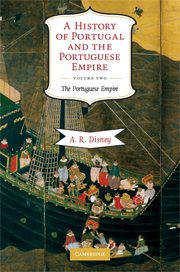Book contents
- Frontmatter
- Contents
- Abbreviations
- List of maps
- Preface
- Maps
- 15 North Africa
- 16 Exploring the Coasts of Atlantic Africa
- 17 Engaging with Atlantic Africa
- 18 The Atlantic Islands and Fisheries
- 19 Breakthrough to Maritime Asia
- 20 Empire in the East
- 21 Informal Presence in the East
- 22 Brazil: Seizing and Keeping Possession
- 23 Formation of Colonial Brazil
- 24 Late Colonial Brazil
- 25 Holding on in India: The Late Seventeenth and Eighteenth Centuries
- 26 Eastern Empire in the Late Colonial Era: Peripheries
- Glossary
- Bibliography
- Index
22 - Brazil: Seizing and Keeping Possession
Published online by Cambridge University Press: 05 June 2012
- Frontmatter
- Contents
- Abbreviations
- List of maps
- Preface
- Maps
- 15 North Africa
- 16 Exploring the Coasts of Atlantic Africa
- 17 Engaging with Atlantic Africa
- 18 The Atlantic Islands and Fisheries
- 19 Breakthrough to Maritime Asia
- 20 Empire in the East
- 21 Informal Presence in the East
- 22 Brazil: Seizing and Keeping Possession
- 23 Formation of Colonial Brazil
- 24 Late Colonial Brazil
- 25 Holding on in India: The Late Seventeenth and Eighteenth Centuries
- 26 Eastern Empire in the Late Colonial Era: Peripheries
- Glossary
- Bibliography
- Index
Summary
EARLY VOYAGES AND THE AGE OF FEITORIAS
It is uncertain today which European voyager was the first to sight the coast of Brazil, or precisely where. A Portuguese expedition commanded by Duarte Pacheco Pereira may have explored off Pará and Maranhão in 1498, though the evidence for this is slight and inconclusive. In January 1500, the Spanish navigator Vicente Yáñez Pinzón certainly reached somewhere in northeastern South America and possibly sailed along part of Brazil's northern coast, discovering en route the mouth of the Amazon. But there is much uncertainty about exactly where Pinzón went, he may never have reached Brazil at all and the great river he encountered might have been the Orinoco. Moreover, whatever the truth about the Pinzón voyage, it was not followed up and had little direct bearing on the future of Brazil.
The first European landing in Brazil for which irrefutable evidence exists was made by men of a Portuguese fleet commanded by Pedro Álvares Cabral, en route to India, in April 1500. The immediate circumstances of Cabral's visit are clear enough. After Vasco da Gama's return from Calicut in 1499 King Manuel resolved to dispatch to India a second, much larger fleet, comprising thirteen ships, of which he gave Cabral command. Cabral himself came from a minor noble family of Beira Baixa with strong links to the house of Viseu – the house of King Manuel.
- Type
- Chapter
- Information
- A History of Portugal and the Portuguese EmpireFrom Beginnings to 1807, pp. 204 - 231Publisher: Cambridge University PressPrint publication year: 2009



